5.3 Oral Routes of Administration
Any medication administration that passes through the gastrointestinal (GI) tract for systemic circulation (such as through the mouth or a feeding tube) is referred to as an enteral route of administration. Enteral administration by drinking, swallowing whole, or chewing and swallowing is also known as the oral route of administration. However, the term oral can also refer to a medication applied topically to the mouth (as in the localized treatment of a cold sore) or to other dosage forms that are put into the mouth cavity, so the term can be confusing. Physicians use the prescription abbreviation po (from the Latin term per os, meaning “by mouth”) to indicate the swallowing route of medication administration.
 Put Down Roots
Put Down Roots
The term enteral comes from the Greek word enteron, which means “intestine.”
Oral (enteral) dosage forms proceed through a series of discrete steps: passing through the mouth and throat into the stomach; dissolving and absorbing in the stomach or small intestine; metabolizing (the transformation of food into energy) in the liver; distributing to the tissue or target organ; and eliminating the remnants from the body, often via the kidneys. Because of these many progressive steps, oral tablets, capsules, and liquids generally all have a delayed systemic effect of at least 30 minutes or longer.
 Pharm Fact
Pharm Fact
The absorption rate of different oral medications is determined by many factors, such as the type of drug, the presence of food in the digestive tract, and any digestive disorders.
Some drugs are administered in the mouth but not swallowed. These oral drug forms are absorbed by the inner linings of the mouth through the mucous layers. Any drugs absorbed by the mucus layers are called transmucosal. The two oral transmucosal routes of administration are the sublingual route of administration, where a medication is dissolved and absorbed under the tongue, and the buccal route of administration, where a medication is dissolved and absorbed between the cheek and gums. These transmucosal drug forms are considered different from the general oral dosage forms because the medications are absorbed directly in the mouth rather than going through the digestive system; they will be explained in more detail later.
Tablets, capsules, solutions, suspensions, syrups, and elixirs are all common oral (enteral) dosage forms that are swallowed. In general, oral dosage forms offer convenience, safety, and ease of use. However, these medications also have disadvantages associated with their passing through the digestive tract, which include delayed onset and absorption, and destruction of some of the medicinal power of the drug by digestive fluids. Each dosage form has a unique set of benefits and drawbacks that pharmacy technicians must know to provide safe and effective care.
 Safety Alert
Safety Alert
The oral route of administration is not appropriate for patients who are experiencing nausea or vomiting.
Tablets
Tablets are one of the most common forms of oral administration. The tablet is a solid dosage form produced by compressing dry drug ingredients of either powder or granules (small particles or crystals). Tablets are available in a wide variety of shapes, sizes, surface markings, and coatings. Most tablets are imprinted with a distinctive letter and/or numerical code as well as coloring from their manufacturers for drug identification purposes. Drugs may come in a variety of salt and tablet dosage forms.
Tablets are easier and less costly to produce in bulk than other forms, so they are often cheaper. For patients, tablets offer low cost, more precise dosing, and increased usability due to specialized coatings. They offer high physical, chemical, and antimicrobial stability so that they can have a long shelf life in the pharmacy and at home.
Tablets have some major disadvantages:
delayed onset of action because the dosage form must disintegrate in the stomach and small intestine before being absorbed
destruction of the drug by GI fluids
local GI side effects in the stomach, such as nausea, heartburn, or ulcers
delayed absorption of the medication because food is present in the stomach
ineffectiveness for patients who are experiencing nausea or vomiting or who are comatose, sedated, or otherwise unable to swallow
All oral distribution forms that involve swallowing include these disadvantages to a lesser extent. Delayed-release (DR) formulation tablets address some of these concerns (to be explained in more detail later in this chapter). Because the release is slower and more gradual, the longer duration of action usually produces fewer side effects and requires a reduced dosing schedule. Consequently, the DR tablet form improves patient adherence and patient outcomes. DR tablets, though, also have several disadvantages. They have a slower onset of action, cannot usually be split or crushed, can have prolonged side effects, and are more expensive. (See Table 5.3 for examples of DR tablets.)
Table 5.3 Common Brand Names of Delayed-Release Tablets and Capsules*
Adalat CC (nifedipine ER) Adderall XR Ambien CR Augmentin XR Calan SR (verapamil ER) Concerta Depakote ER (divalproex DR/ER) Diltia XT (diltiazem SR/XT) Ditropan XL Effexor XR Glipizide XL |
Glucotrol XL Glucophage XR (metformin ER) Inderal XL (propranolol ER) Indocin SR Klor-Con (potassium chloride) Lamictal XR MS Contin Niacin SR OxyContin Ritalin LA Seroquel XR |
Sinemet CR (carbidopa-levodopa ER) Taztia XT Toprol XL (metoprolol succinate ER) Uniphyl (theophylline ER) Voltaren XR (diclofenac ER) Wellbutrin SR/XL (budeprion SR/XR) Xanax XR (alprazolam ER) |
|
* Do not split tablets or open up capsules. |
||
Tablet Types
Tablets can be designed to be easily swallowed, mask a drug taste, or exert an immediate pharmacological response. The different intentions result in different types of tablets.
Compression Tablets Large pharmaceutical manufacturers use heavy tool and die machinery to make compression tablets by several methods. In the direct compression process, the powder or granular ingredients are compressed to produce a tablet as the end product. Standard one-pass compression tablets are the most inexpensive and common dosage form used today. Acetaminophen (Tylenol) is an example of a compression tablet.
 Pharm Fact
Pharm Fact
A common chewable adult tablet is 81 mg of aspirin.
Multiple Compression Tablets A multiple compression tablet (MCT) is produced by multiple compression cycles and is, in effect, either a tablet on top of a tablet or a tablet within a tablet. An MCT may contain a core and one or two outer shells (or two or three different layers, as shown in Figure 5.1), each containing a separate medication and colored differently. MCTs are created for appearance alone or to combine incompatible substances into a single medication. The Ambien CR (zolpidem tartrate) brand is an example of an MCT.
Figure 5.1 Multiple Compression Tablets
(a) Two layers or compressions (b) Three layers or compressions
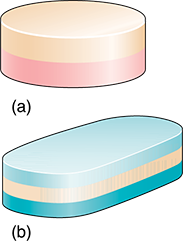
Chewable Tablets A chewable tablet contains a base that is flavored and/or colored. The dosage form is designed to be masticated (chewed) and absorbed quickly for a slightly faster onset of action. Chewing is preferred for antacids, antiflatulents, commercial vitamins, and tablets designed for children. They can be prescribed for small children in lieu of other dosage forms. For example, the drug montelukast (Singulair), used to control asthma symptoms, and the drug amoxicillin, used to treat infections, are both available in a children’s chewable tablet form.
Oral Disintegrating Tablets An oral disintegrating tablet (ODT) is designed to melt in your mouth. ODTs are useful for pediatric and geriatric patients who have difficulty swallowing or for patients with nausea and vomiting. Examples include rizatriptan (Maxalt) for the treatment of migraine headaches, donepezil (Aricept) for the treatment of Alzheimer’s disease, and ondansetron (Zofran) for the treatment of nausea and vomiting.
Caplets Some pharmaceutical companies manufacture an oblong tablet called a caplet. The caplet is simply a tablet shaped and sometimes coated to look like a capsule. The inside of the caplet is solid rather than filled with powder or granular material like the inside of a capsule. Caplets have many beneficial properties. They are easier to swallow than large tablets, have a longer shelf life, and—unlike capsules—are tamper-proof. Caplet formulations on the market include the OTC drug brand naproxen (Aleve) and the prescription drug brand oxaprozin (Daypro).
Tablet Coatings and Additives
Most compression tablets are uncoated, but some tablet dosage forms are covered by a special outside layer that dissolves or ruptures in the stomach or small intestine. Coatings on tablets can be used to improve appearance, flavor, or ease of swallowing. Common tablet coatings include sugar or a film coating.
A sugar-coated tablet (SCT) contains an outside layer of sugar that protects the medication and improves both appearance and flavor. Sugar coating masks the bitter taste of some drugs (such as ibuprofen) and increases the stability of the drug. The major disadvantage of a sugar coating is that it makes the tablets much larger, heavier, and more difficult to swallow. An SCT could be crushed, but the bitterness of the drug would no longer be masked. Most multivitamins contain a sugar coating to mask the bitter smell and taste of the vitamins, especially prenatal vitamins.
A film-coated tablet (FCT) contains a thin outer layer of a polymer (a substance containing very large molecules) that can be either soluble or insoluble in water. Film coatings are thinner, lighter in weight, and more efficient and less expensive to manufacture than sugar coatings. They are colored to provide an attractive appearance and, at times, to protect the stomach lining or delay the release of the drug. An enteric coating is a special coating designed to resist destruction by gastric fluids. This film barrier also protects the drug from being digested and released too quickly. (For more discussion on enteric coatings, see the section titled “Drug Delivery Systems” later in this chapter.) Certain dosage forms of the antibiotics erythromycin (Erythrocin) and metronidazole (Flagyl) have enteric coatings to prevent serious GI side effects that commonly occur with these drugs. An FCT can be crushed, but doing so may lose its taste-masking benefit.
A buffered tablet, as in “buffered aspirin,” is a tablet in which an antacid, such as calcium carbonate, is added to the medication to reduce the stomach acids that can cause both abdominal distress and damage to the stomach lining.
Capsules
The active ingredient(s) of a capsule are commonly in the form of a granular powder or liquid gel that is enclosed by a gelatin shell. Gelatin is a protein substance obtained from vegetable matter and/or from the skin, connective tissue, and bones of animals. The gelatin shell of the capsule can be hard or soft, and it may be transparent, semitransparent, or opaque. It may be colored or marked with a code to facilitate identification. The “body” is the longer portion that is filled, and the “cap” covers it. In commercial manufacturing, the body and the cap are usually sealed to protect the integrity of the drug within and to prevent tampering. Because a capsule encloses the drug components, flavorings are not common for this dosage form.
Compared with tablets, capsules are typically easier to swallow, have a more rapid dissolution, and have a faster onset of action. Capsules, though, do not allow as much dosage manipulation as tablets or liquid formulations. The contents of most immediate-release capsules, however, can be mixed with water and administered to a child or to a patient with an enteral or a nasogastric feeding tube. Some capsules are used to compound specific oral solutions.
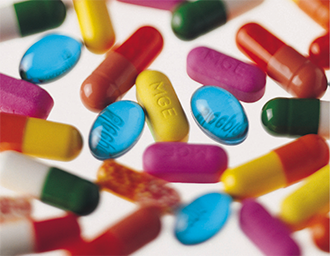
Capsules and tablets are manufactured in a variety of sizes, shapes, and colors to help patients identify their different drugs.
Liquid Dosage Forms
Most medicinal liquids are commercially available as solutions (such as syrups and elixirs), suspensions, emulsions, and colloids for oral administration, each of which will be explained later in this section. Liquids consist of one or more active ingredients in a liquid vehicle. Liquids have several advantages as a dosage form, including a faster onset of action than oral tablets or capsules, easy administration, and individualized dosing according to a patient’s body weight.
 Practice Tip
Practice Tip
Some patients, for personal or religious purposes, might avoid certain animal products. Be aware that gelatin in capsules is often from cows or pigs. Patients may prefer vegetarian sources for capsules.
Liquid medications are also ideal for certain age groups. For young children, liquids have easier dosage adjustments. For example, a flavored antibiotic liquid or suspension can be accurately dosed based on a patient’s body weight and may be preferable to a tablet or capsule. For geriatric patients, liquid medications are easier to swallow, especially for those patients with swallowing difficulties due to Parkinson’s disease or cancer. For patients who have to swallow large tablets, such as potassium chloride, prescribers can order a liquid formulation that offers the same dose and has the added benefit of less GI upset.
Liquids also have a few disadvantages. Liquid dosage forms are often less stable than their solid dosage tablet and capsule counterparts. Consequently, pharmacy personnel should monitor proper storage conditions of liquid medications, rotating and checking stock for expiration dates.
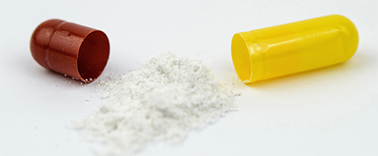
A capsule includes a cap (red) and a body (gold) that is filled with medication..
Solutions
 Practice Tip
Practice Tip
Patients need to be reminded to shake suspensions before each use. For a patient who has difficulty with this, another dosage form might be best, as recommended by the pharmacist. Following the directions for refrigeration or storage at room temperature is also important.
A solution is a liquid in which the active ingredients are completely dissolved in a liquid vehicle so that they appear transparent (as opposed to murky). Each solution has the drug agent dissolved in a liquid base that composes most of the solution called a solvent. Solutions are often classified by their liquid base: aqueous solutions are water-based; alcoholic solutions are alcohol-based; and hydroalcoholic solutions are water-based and alcohol-based. The ingredient dissolved in the solution is known as the solute. Promethazine hydrochloride (Phenergan) is an example of a prescription drug for nausea that is available as a solution (also as a tablet and a suppository).
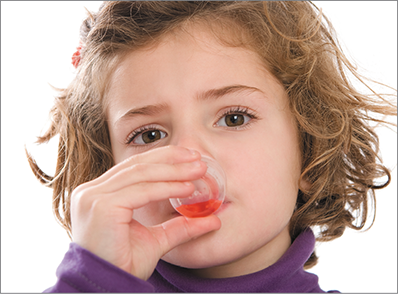
Many prescription and OTC medications for children come in flavored syrup formulations with high sugar or corn syrup content.
Most liquid formulations for children are syrups or elixirs flavored to mask the taste and ease the swallowing of the medication. Syrups (as in cough medicines) are preferred because they do not contain alcohol.
Syrups A syrup is an aqueous solution thickened with a large amount of sugar—generally sucrose—or a sugar substitute, such as sorbitol or propylene glycol. Syrups are classified as medicated and nonmedicated. Examples of medicated syrups include lithium citrate (Phenergan) for bipolar depression, ranitidine hydrochloride (Xantac) for heartburn, or cetirizine hydrochloride (Zyrtec) for allergies.
 Safety Alert
Safety Alert
Because of their high sugar content, syrups should be used cautiously in patients with diabetes, especially children.
Syrups usually contain additional flavorings, colorings, or aromatic agents. Codeine and guaifenesin Cheratussin AC is a medicated prescription cough medicine that contains more than 10 inactive ingredients, including several flavoring agents. Common nonmedicated syrups include fruits or cocoa syrups used to make flavored drinks.
The higher sugar content of syrups can pose problems for patients with diabetes. Therefore, pharmacists generally recommend sugar-free OTC products for this patient population. In contrast, some less sugary suspensions, such as amoxicillin/clavulanate (Augmentin) and clindamycin (Cleocin), have the disadvantage of unpleasant taste. Although the taste of medication can be masked by various flavorings to promote adherence, certain flavorings may be physically incompatible with components of the suspension. With that in mind, pharmacy technicians must follow proven “recipes” when selecting the proper flavoring agent. (The role of the pharmacy technician in flavoring suspensions is further discussed in Chapter 7.) The fact that suspensions have to be shaken by the patient before every use can be another disadvantage.
Elixirs An elixir is a clear, sweetened, flavored solution containing ethanol with the water base (hydroalcoholic). An example of a drug in this dosage form is phenobarbital elixir, which contains phenobarbital, orange oil, propylene glycol, sorbitol solution, color, alcohol, and purified water. This elixir is used to treat anxiety and seizures.
Less Common Solutions Other available solutions include aromatic water, fluidextracts, solid extracts, tinctures, and spirits:
An aromatic water is a solution of water containing oils or other substances that have a pungent and usually pleasing smell and are volatile (i.e., easily released into the air). Rose water is an example.
A fluidextract is a liquid dosage form, such as an oil or sap, extracted from plant sources and commonly used in the formulation of syrups. Vanilla extract is an example of a fluidextract.
A solid extract is a potent dosage form derived from animal or plant sources from which most or all of the liquid has been evaporated to produce a powder, an ointment-like form, or solid matter. Some extracts are reduced down from fluidextracts and used in the formulation of medications. Dried herbal leaves are examples of a solid extract.
A tincture is made by combining a fluid- or solid extract with an alcoholic or hydroalcoholic solution. Examples include iodine and belladonna tinctures, and some herbal dietary supplements.
A spirit is an alcoholic or hydroalcoholic solution containing aromatic ingredients that can easily enter the air as gases, so they are less stable. Examples include camphor and peppermint spirit, both of which can be used as medicines or flavorings.
Suspensions
Unlike a solution, a suspension is a liquid medication in which the solid particles of the substance remain undissolved in the liquid even after mixing, so the medication appears murky or cloudy. The solid drug ingredient particles can be from powders or granulated crystals. A suspension is considered a dispersion because the medication is simply mixed to have the particles evenly dispersed, or distributed, throughout the liquid base. As noted, they have to be mixed again, often by shaking by the patient, to keep them combined.
 Practice Tip
Practice Tip
Pharmacy technicians should always “shake well” a stock bottle of an oral suspension before transferring the medication to a smaller, labeled prescription bottle.
Like solutions, suspensions often contain many inactive ingredients, including colorings, coatings, and flavorings, such as the cherry-mint Nystatin oral suspension (an antifungal treatment). Some suspensions are commercially available over the counter, such as Mylanta (both a combination of aluminum hydroxide, magnesium hydroxide, and simethicone) and Motrin and Advil (or ibuprofen) oral suspensions. Others come in the form of dry powders or granules that are mixed or reconstituted by the pharmacist or pharmacy technician with purified distilled water prior to dispensing to the patient.
Antibiotic suspensions are often mixed by adding sterile water to irregular-shaped granules, which are not as likely as powders to float on the surface of a liquid. These suspensions have excellent flow characteristics and are more stable than those mixed from powders. A well-prepared suspension pours easily and settles slowly but can be redispersed quickly by gentle shaking.
Most antibiotic suspensions have a limited shelf life. In fact, the expiration date for most reconstituted antibiotic suspensions or those mixed with water is 7 to 10 days at room temperature and 14 days if stored in the refrigerator. Pharmacy technicians should also be aware that some antibiotics, such as cefdinir and azithromycin, are best stored at room temperature after reconstitution and should not be placed in the refrigerator. Consequently, it is key that technicians address medication storage requirements with patients during pickup.
Emulsions
Another type of dispersion is known as an emulsion. An emulsion is a mixture of two unblendable substances, such as an oil-and-vinegar salad dressing. It must be shaken well to mix it evenly before use. Medicated emulsions often contain an emulsifying agent that makes the liquid more stable and less prone to separation by binding the two ingredients together. Pediacare Gas Relief Drops is a commercially available oral emulsion of simethicone. Many skin care products on the market are emulsions.
Colloids
A colloid is a mixture having physical properties between those of a solution and a fine suspension. A magma, or milk-like liquid, is an example of a dispersion containing ultrafine colloidal particles in a suspension. An example of a magma is Milk of Magnesia, which contains magnesium hydroxide and is used to neutralize gastric acid. Another type of colloidal dispersion is the microemulsion, or a liquid that is dispersed in another liquid. Unlike other emulsions, however, it is clear because of the extremely fine size of the droplets of the dispersed phase. An example of a microemulsion is Haley’s M-O (magnesium and mineral oil).
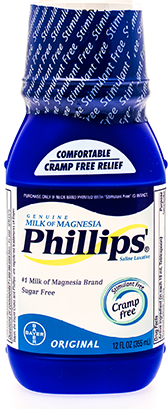
Milk of magnesia, which helps with stomach distress, is an example of a colloid mixture.
Powders and Effervescent Salts
Other oral dosage forms like powders and effervescent salt mixtures that patients add to water are less frequently prescribed. They are often OTC medications and home-style remedies. Still, these dosage forms offer some advantages over tablets and capsules for those who have difficulty swallowing tablets or capsules.
Powders
A powder is a preparation in the form of fine particles. Commonly requested OTC powders include Goody’s (acetaminophen, aspirin, and caffeine) and BC (aspirin and caffeine) headache powders, brewer’s yeast, and fiber laxatives (such as Metamucil). The headache powders take less time to dissolve than tablets and are thought to work more quickly than tablets in relieving a headache. In large-scale commercial manufacturing, as well as in compounding pharmacies, powders are milled and pulverized by machines and placed into gelatin capsules. Some patients simply drop a teaspoon of baking soda into a glass of water as a home remedy for stomach distress.
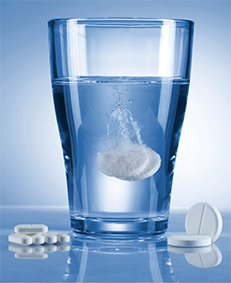
Effervescent salts release carbon dioxide gas when added to water.
Effervescent Salts
An effervescent salt is a mixture of granules or coarse powders that contains one or more medicinal agents (such as an analgesic) as well as some combination of sodium bicarbonate with citric acid, tartaric acid, or sodium biphosphate. When dissolved in water, the effervescent salts release carbon dioxide gas, causing a distinctive bubbly or fizzy appearance and sound. Most people are familiar with effervescent tablets, such as the common OTC immunity builder Airborne (a dietary supplement) or the Alka-Seltzer line of products that are used to relieve headaches, hangovers, or indigestion. Alka-Seltzer once had the marketing tagline “Plop plop, fizz fizz, oh what a relief it is!” that makes it easy to remember what an effervescent salt is.
Patient Administration of Oral Dosage Forms
When patients receive a new oral medication, it is important for technicians to guide them to the pharmacist for counsel before they leave the store. The pharmacist should discuss with the patient what drinks and foods to take with the medications as well as which consumables to avoid. For most medications, water is preferred to coffee, tea, juices, or carbonated drinks as an aid in swallowing. In fact, some beverages—such as milk, coffee, and tea—may inactivate certain antibiotics and osteoporosis medications.
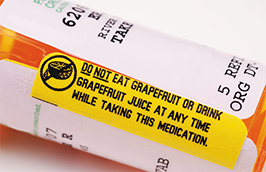
Pharmacists may direct technicians to apply auxiliary labels to prescription containers to aid patient use.
Pharmacists also need to counsel patients as to behaviors to avoid while taking medications. Some of these curtailed behaviors include alcohol consumption, sun exposure, and driving. To remind patients of these medication restrictions, as explained in the previous chapter, you can affix auxiliary labels to the drug containers.
It is also usually up to the pharmacy technician to explain to patients how to properly store their oral medications. In addition, specific oral dosage forms have their unique dispensing and administration guidelines, as discussed below.
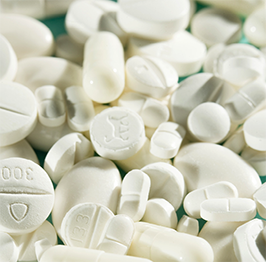
Tablets that are meant to be split have a prepressed scoring line for easy breakage in halves or fourths.
Tablet Administration
Patients who have difficulty swallowing solids should be instructed to place the tablet on the back of the tongue and tilt the head backward, which will stimulate swallowing. Patients should also be reminded not to crush (or split) tablets that are intended to be swallowed whole, such as any delayed-release or enteric-coated drug.
 Practice Tip
Practice Tip
It is important to make patients aware that, although careful tablet splitting may reduce medication costs, it is not recommended for all drugs.
For traditional tablets that are not delayed-release, a patient can take a portion of a tablet, one tablet, or several tablets as the prescribed dose or as personal adjustment requires. Many tablets are scored once or twice by the manufacturer to facilitate ease of breakage into portions for half (or even quarter) doses. The scoring, or indenting, of a tablet is designed to (almost) equally divide the dose in each section or quadrant.
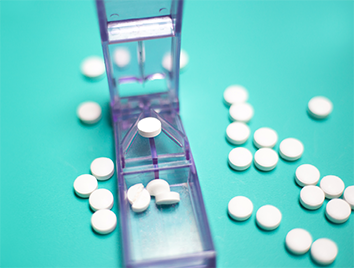
A tablet splitter can save money for patients taking high-cost medications, especially for chronic medical conditions.
Due to rising drug costs, patients commonly use a tablet splitter to break both scored and unscored tablets when treating chronic conditions, such as high blood pressure. Under a healthcare provider’s oversight, a patient can use a tablet that is twice the strength of their intended dose and only ingest half a tablet per dose. Splitting medications can save up to double the price for patients, and limited studies suggest that this practice with select medications does not appreciably affect the control of the disease state. Patients should keep in mind that not all tablets can be split in equal doses even with the use of a tablet splitter. For example, odd-shaped tablets such as valsartan (Diovan) or tadalafil (Cialis) are particularly difficult to cut.
If a tablet is not scored, it is generally recommended that it should not be split because the dose may not be equal in each piece. Based on results of scientific studies, the Food and Drug Administration (FDA) has approved a limited number of prescription drugs for tablet splitting.
Capsule Administration
As with tablets, patients who have difficulty swallowing solids should place the capsule on the back of the tongue and tilt the head backward to ease the process. Some formulations, such as Theo-Dur Sprinkles (theophylline) and divalproex sprinkle capsules, are suitable to be opened up and sprinkled on food when swallowing proves difficult for a child or an adult with asthma or seizures. Again, patients should be reminded not to open capsules that are intended to be swallowed whole, such as any delayed-release drug.
 Safety Alert
Safety Alert
To reduce errors in medications, it is recommended to provide metric dosing cups, spoons, and oral syringes to patients instead of relying on household teaspoons and tablespoons for measurement.
Liquid Administration
It is also important to remind patients that liquid medication doses should be accurately measured in a medication cup or measuring spoon. Common household utensils are often inaccurate measurements of a “teaspoonful” (5 mL) or “tablespoonful” (15 mL). Oral and tuberculin syringes, measuring spoons, medication cups, and droppers are commonly dispensed in the hospital and community pharmacy settings to administer doses ranging from 0.1 mL to 30 mL. Specific information on some of these pharmacy measurement devices is discussed below.
 Practice Tip
Practice Tip
Pharmacy technicians should be aware that the abbreviation “gtt” (from the Latin guttae meaning “drops”) is used as a measurement for droppers as well as for IV infusions.
Oral Syringes An oral syringe is used to measure and deliver oral liquid medications to pediatric patients. This type of syringe is a calibrated device consisting of a plunger and a cannula, or barrel, and is used without a needle to administer precise amounts of medication by mouth. Oral syringes may be used to slowly administer liquid medications to not only pediatric patients, but patients who cannot open their mouths. For very small doses (less than 1 mL) for an infant, a 1 mL tuberculin syringe (again, without the needle) may be provided.
Medication Cups Most manufacturers provide a medication cup for OTC liquids that are used to treat fever, cough, cold, and the like. These plastic cups contain specific dose demarcations in different units of measurement, such as 1 teaspoonful (5 mL), 2 teaspoonfuls (10 mL), and 1 tablespoonful (15 mL). Parents or caregivers should be directed to check the OTC package label for the specific dose appropriate for their child’s age and weight or to ask the pharmacist. Measuring cups that also list fluid drams (an apothecary measurement equal to approximately 3.7 mL) should be disposed of to avoid accidental mistakes in dosing, which have happened even in hospitals.
 Safety Alert
Safety Alert
Reconstituted products are less stable than other products. Pharmacy technicians should always point out the manufacturer’s recommendations for storage and the expiration dates.
Droppers Droppers are critically important for delivering the correct dosage of smaller volumes of medication to infants and children. A dropper contains a small, squeezable bulb at one end and a hollow glass or plastic tube with a tapering point on the other end. Squeezing the bulb creates a vacuum for drawing up a liquid. A dropper is commonly calibrated to deliver 1.25 mL (one-fourth teaspoon) to 2.5 mL (one-half teaspoon). Because different medicines may each have a different viscosity (fluid thickness and flow characteristics), the size of a drop varies considerably among different suspensions and solutions. In light of that, droppers that are packaged with medications can only be used to measure those specific medications.
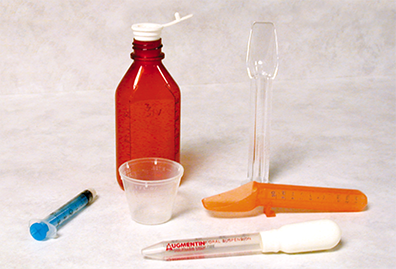
Parents can offer their infants or young children more accurate dosing of liquid medications when they are administered with one of these devices (syringe, cup, dropper, or measuring spoon).